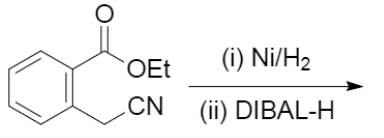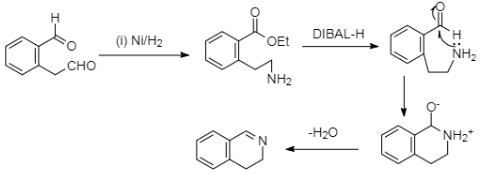
The major products of the following reaction is:

A.

B.

C.

D.






Answer
467.4k+ views
Hint:In organic chemistry, in order to predict the final product, the most effective way is to determine the mechanism of the whole reaction in a stepwise manner.
The properties and functions of specific reagents are a crucial part of any mechanism as it provides a clear idea as to what would happen to the organic compound in the next step.
Complete step-by-step answer:In the given half reaction, we can see that the

Now, we will consider this mechanism of the reaction in a stepwise manner. At first as we already know, the cyanide group gets reduced to an amine group because of nickel and hydrogen. And, in the next step the ethoxy group which is a part of the ester group, gets reduced to hydrogen because of the reagent di-isobutylaluminium hydride or ‘DIBAL-H’. In the next step the lone pair of electrons which are present in the nitrogen of the amine group gets transferred to the partially positive carbonyl carbon in which the bond polarity developed because of the electronegative character of the oxygen. Now, the loss of proton takes place and the nitrogen gets attached to the carbonyl carbon. In the last step, the loss of water takes place, as in, two protons from the amine group and an oxygen from the carbonyl group, which ultimately creates a double bond between the carbon and the nitrogen in the ring.
Now, if we look at the options which are provided to us in the question, we can see that option B is the correct one.
So, the appropriate answer is option B.
Note:The reagent di-isobutylaluminium hydride or ‘DIBAL-H’ is a type of reducing agent which works on the esters and aldehyde groups on any organic compound.
It is a very specific reagent and does not work on alcoholic groups, it only acts on aldehydes as well as esters containing groups.
The properties and functions of specific reagents are a crucial part of any mechanism as it provides a clear idea as to what would happen to the organic compound in the next step.
Complete step-by-step answer:In the given half reaction, we can see that the

Now, we will consider this mechanism of the reaction in a stepwise manner. At first as we already know, the cyanide group gets reduced to an amine group because of nickel and hydrogen. And, in the next step the ethoxy group which is a part of the ester group, gets reduced to hydrogen because of the reagent di-isobutylaluminium hydride or ‘DIBAL-H’. In the next step the lone pair of electrons which are present in the nitrogen of the amine group gets transferred to the partially positive carbonyl carbon in which the bond polarity developed because of the electronegative character of the oxygen. Now, the loss of proton takes place and the nitrogen gets attached to the carbonyl carbon. In the last step, the loss of water takes place, as in, two protons from the amine group and an oxygen from the carbonyl group, which ultimately creates a double bond between the carbon and the nitrogen in the ring.
Now, if we look at the options which are provided to us in the question, we can see that option B is the correct one.
So, the appropriate answer is option B.
Note:The reagent di-isobutylaluminium hydride or ‘DIBAL-H’ is a type of reducing agent which works on the esters and aldehyde groups on any organic compound.
It is a very specific reagent and does not work on alcoholic groups, it only acts on aldehydes as well as esters containing groups.
Latest Vedantu courses for you
Grade 8 | CBSE | SCHOOL | English
Vedantu 8 CBSE Pro Course - (2025-26)
School Full course for CBSE students
₹45,300 per year
Recently Updated Pages
Master Class 12 Biology: Engaging Questions & Answers for Success

Class 12 Question and Answer - Your Ultimate Solutions Guide

Master Class 12 Business Studies: Engaging Questions & Answers for Success

Master Class 12 Economics: Engaging Questions & Answers for Success

Master Class 12 Social Science: Engaging Questions & Answers for Success

Master Class 12 English: Engaging Questions & Answers for Success

Trending doubts
An example of ex situ conservation is a Sacred grove class 12 biology CBSE

The total number of isomers considering both the structural class 12 chemistry CBSE

What is the Full Form of PVC, PET, HDPE, LDPE, PP and PS ?

Observe the sketch of stirredtank bioreactor and label class 12 biology CBSE

The Dimensional formula for the electric field is -class-12-physics-CBSE

How do you convert from joules to electron volts class 12 physics CBSE




